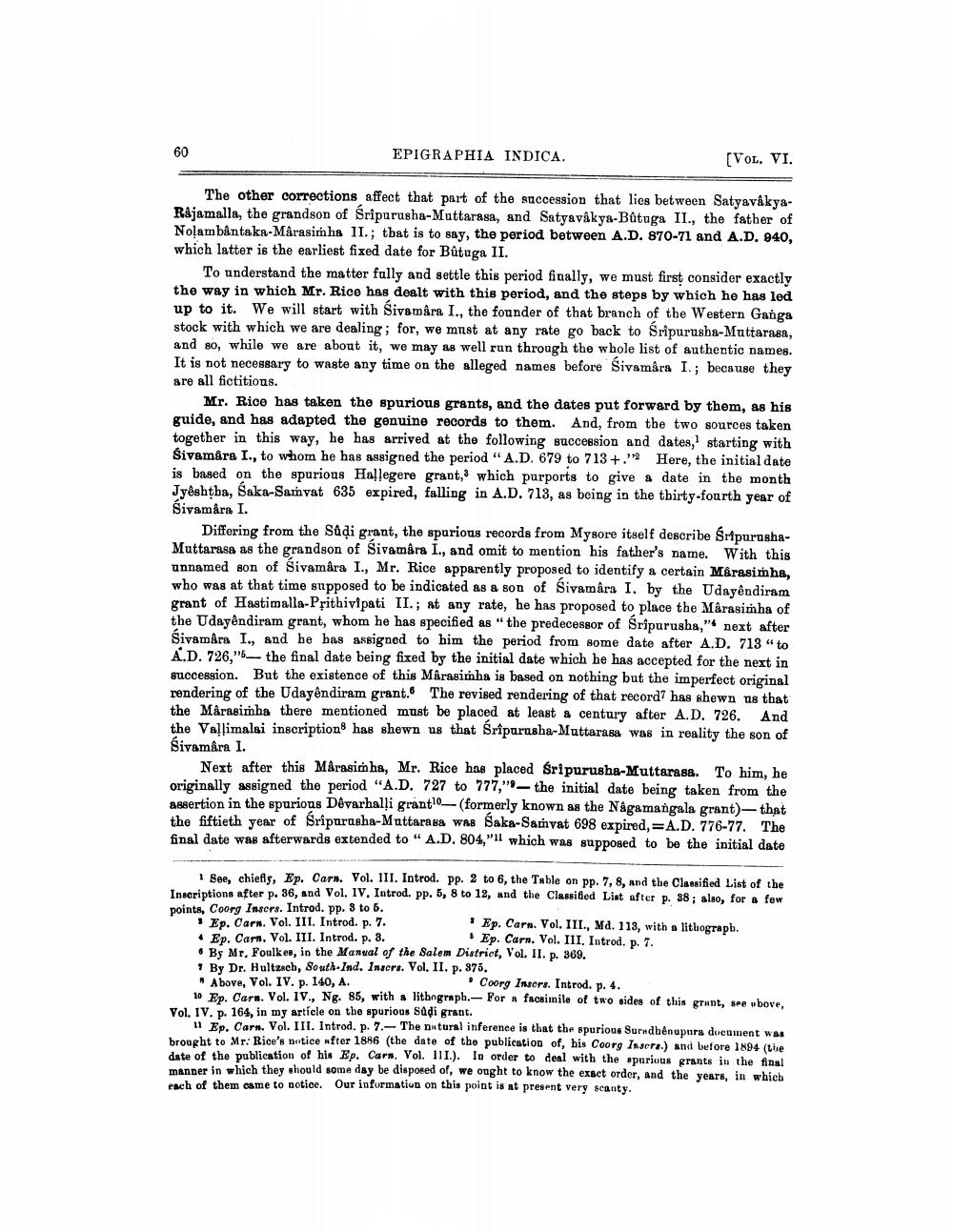________________
60
EPIGRAPHIA INDICA.
[VOL. VI.
The other corrections affect that part of the succession that lies between SatyavákyaRajamalla, the grandson of Sripurusha-Muttarasa, and Satyavákya-Bütuga II., the father of Nolambântaka-Márasimha 11.; tbat is to say, the period between A.D. 870-71 and A.D. 940, which latter is the earliest fixed date for Bûtuga II.
To understand the matter fully and settle this period finally, we must first consider exactly the way in which Mr. Rice has dealt with this period, and the steps by which he has led up to it. We will start with Sivam&ra I., the founder of that branch of the Western Ganga stock with which we are dealing; for, we must at any rate go back to Sripurusha-Muttarasa, and so, while we are about it, we may as well run through the whole list of authentic names. It is not necessary to waste any time on the alleged names before Sivamâra I.; because they are all fictitious.
Mr. Rice has taken the spurious grants, and the dates put forward by them, as his guide, and has adapted the genuine records to them. And, from the two sources taken together in this way, he has arrived at the following succession and dates, starting with Śivamâra I., to whom he has assigned the period " A.D. 679 to 713+. Here, the initial date is based on the spurious Hallegere grant, which purports to give a date in the month Jyêshtba, Saka-Samvat 635 expired, falling in A.D. 713, as being in the thirty-fourth year of Sivamára I.
Differing from the Sadi grant, the spurious records from Mysore itself describe ŚripurushaMuttarasa as the grandson of Sivamêra I., and omit to mention his father's name. With this unnamed son of Sivamâra I., Mr. Rice apparently proposed to identify a certain Mêrasimha, who was at that time supposed to be indicated as a son of Sivamâra I. by the Udayêndiram grant of Hastimalla-Prithivipati II.; at any rate, he has proposed to place the Marasimha of the Udayêndiram grant, whom he has specified as "the predecessor of Sripurusha," next after Śivamâra I., and he has assigned to him the period from some date after A.D. 713 " to A.D. 726,"5_ the final date being fixed by the initial date which he has accepted for the next in succession. But the existence of this Marasimha is based on nothing but the imperfect original rendering of the Udayêndiram grant. The revised rendering of that record7 has shewn us that the Marasimha there mentioned must be placed at least a century after A.D. 726. And the Vallimalai inscription has shewn us that Sripurusha-Muttarasa was in reality the son of Sivamâra I.
Next after this Marasimha, Mr. Rice has placed Sripurusha-Muttarasa. To him, he originally assigned the period "A.D. 727 to 777,""- the initial date being taken from the assertion in the spurious Dêvarhalli granto_(formerly known as the Nagamangala grant)- that the fiftieth year of Sriparusha-Muttarasa was Saka-Samvat 698 expired,=A.D. 776-77. The final date was afterwards extended to " A.D. 804,"Il which was supposed to be the initial date
1 See, chiefls. Ep. Cars. Vol. III. Introd. Pp. 2 to 6, the Table on pp. 7, 8, and the Classified List of the Inscriptions after p. 36, and Vol. IV. Introd. Pp. 5, 8 to 12, and the Classified List after p. 38; also, for a few pointa, Coorg Insors. Introd. pp. 8 to 5. · Ep. Carn. Vol. III. Introd. p. 7.
Ep. Carn. Vol. III, Md. 113, with a lithograpb. • Ep. Carn, Vol. III. Introd. p. 8.
Ep. Carn. Vol. III. Introd. p. 7. • By Mr, Foulkes, in the Manual of the Salem District, Vol. II. p. 369. 1 By Dr. Hultzaeb, South-Ind. Insers. Vol. II. p. 375. * Above, Vol. IV. p. 140, A.
Coorg Insors. Introd. p. 4. 10 Ep. Carn. Vol. IV., Ng. 85, with a lithograph.- For facsimile of two sides of this grunt, se ubove, Vol. IV. p. 164, in my article on the spurious Sadi grant.
11 Ep. Carn. Vol. III. Introd. p. 7.- The natural inference is that the spurious Surudhénupura document was bronchto Me: Bice's netice after 1886 (the date of the publication of, his Coorg Issers.) and before 1894 (the date of the publication of his Ep. Cars. Vol. 111.). In order to deal with the spurious grants in the final manner in which they should some day be disposed of, we ought to know the exact order, and the years, in which eveh of them came to notice. Our information on this point is at present very scanty.




